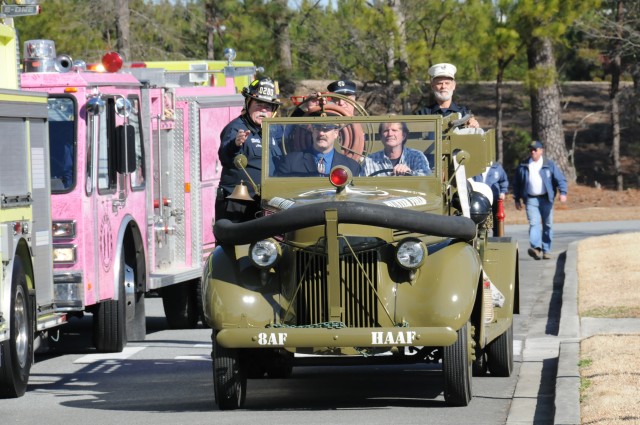
FORT STEWART. Ga. - The shinny, little 1941 Ford Fire Truck affectionately called "Rags" moved slowly toward the entrance of the Mighty Eighth Museum to its final resting place inside among other World War II relics, January 28.
Sporting a new coat of Army green paint, the fire truck hummed sweetly with its original Ford flat-head V-8 engine as it trailed behind an escort of fire trucks from Pooler, Island of Hope and Hunter Army Airfield with their sirens blaring.
Its arrival brought tears to many veterans and friends who watched it driven into place by Allen Deloach, the lead Fort Stewart paint and sheet mechanic from the Directorate of Logistics, who was in charge of the work.
When Brig. Gen. Jeffrey Phillips, deputy commanding general, 3rd Infantry Division, stepped to the ceremonial podium to address the crowd, he confessed his own emotion about Rags. He called the fire truck an 'artifact of hope and dreams' that represent the men and women who died in the fight against tyranny and fascism during WWII.
"The spirit of this little fire engine is soaring," he said, adding that it may sound irrational, but he believes the fire truck has a 'soul' just like the men and women it served. "We have given it back a life."
That early life started at Hunter Army Airfield in 1941 where it remained until 1948, according to Henry Skipper, president, Mighty Eighth Air Force Museum.
In 1947, it became the property of the U.S. Air Force and in 1948, moved from Hunter to Travis Field, where it remained until 1964 when it was purchased as military surplus by the Isle of Hope Volunteer Fire Department in Savannah and affectionately named Rags. In 2000, the Isle of Hope Fire Department donated the fire truck to the Fort Stewart Museum and the U.S. Army Center of Military History, which has loaned Rags for display at the Mighty Eighth Air Force Museum where it will remain.
To show his appreciation for the restoration, Brig. Gen. Phillips presented the Challenge Coin of Excellence to participants of the life-saving effort. Recipients included 12 staff members from the Fort Stewart DOL, who performed 1,000 man hours on the restoration, along with volunteers from the Mighty Eighth Museum. He also recognized the efforts of James Ashdown, Fort Stewart Directorate of Emergency Services and Buck Meeks, 3rd ID museum curator.
"We don't normally get the opportunity to do this type work," said Larry Rohrig, a DOL sheet metal mechanic who admitted that this work was much different from what he and co-workers perform on Army vehicles on a daily basis. "This was a nice change; we really enjoyed it."
"The fire truck looked rough in the beginning," said Deloach, who headed up that crew, "but the motor was in fantastic shape considering its age."
Besides body work, Deloach said his crew tuned and adjusted all the internal components; they upgraded the engine from six to 12 volts and also rewired it to include directional equipment that was not used on the 1941 model.
Deloach said his crew took a lot of pride in the work they performed on the fire truck.
"We thank those who went the extra mile," said Brig. Gen. Phillips, at the conclusion of the ceremony. "It's ready to start over now."
The fire truck's final place of honor is inside the Mighty Eighth Air Force Museum's combat gallery beside the B-17 City of Savannah for visitors to see, according to Vivian Roger-Price, the museum's research center director.

Social Sharing